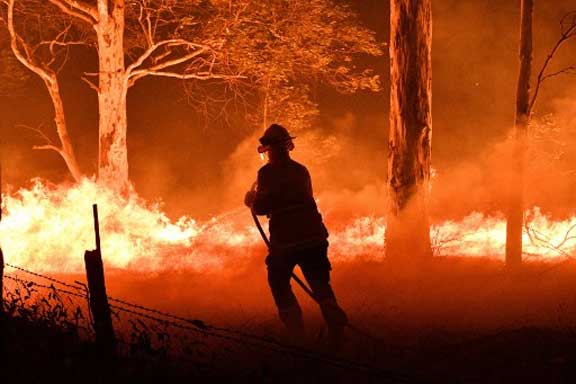Australia fire fighters race to contain blazes as heatwave looms
2:57 PM, Tuesday, January 7th, 2020Sydney : Firefighters raced to quell massive bush fires in southeastern Australia Tuesday, taking advantage of a brief drop in temperatures and some much-needed rainfall before another heatwave strikes later this week.
Exhausted volunteers fixed containment lines, cleared ground vegetation and carried out controlled burns before temperatures and winds were expected to pick up again by Friday.
“It really is about shoring up protection to limit the damage potential and the outbreak of the fires over the coming days,” said New South Wales Rural Fire Service Commissioner Shane Fitzsimmons.
He described current conditions as “much more favorable” but warned, “we are expecting hotter weather to return later in the week”.
Dozens of vast blazes continue to burn out of control across the east of the country and there are growing fears that two fires in New South Wales and Victoria could connect to form other uncontrollable mega blazes.
Rainfall on Monday offered modest relief, but it was not heavy enough to extinguish the fires, and in some places, it hampered firefighters’ preparations by making back-burning more difficult.
Twenty-five people have died since the start of the disaster in September, more than 1,800 homes have been destroyed, and some eight million hectares (80,000 square kilometers) has burned, an area the size of Ireland or South Carolina.
Smoke from the fires has been spotted more than 12,000 kilometers (7,400 miles) away in Chile and Argentina, weather authorities in the South American countries said.
The cost of the disaster is still not clear, but the Insurance Council of Australia said claims worth Aus$700 million ($485 million) had already been filed and the figure was expected to climb significantly.
The government has earmarked an initial Aus$2 billion ($1.4 billion) for a national recovery fund to help devastated communities.
The human toll was again laid bare Tuesday, as firefighters held a memorial in Sydney for 36-year-old colleague Andrew O’Dwyer who died battling blazes in late December.
Volunteers in bright orange fire suits lined the road as his cortege passed – with the coffin draped in a Rural Fire Service flag.
Conditions in the next week are not expected to match the worst days of the crisis, but Fitzsimmons told public broadcaster ABC it was important not to “get lulled into a false sense of security”.
Many of the blazes are too big to be put out, so only sustained rainfall would end the crisis.
Simillar Posts
Warning: count(): Parameter must be an array or an object that implements Countable in /home/megamcaq/public_html/wp-content/plugins/post-plugin-library/common_functions.php on line 357
- None Found
Leave a Reply
© Copyright 2008 www.megamedianews.com All Rights Reserved. Privacy Policy









 Posted in
Posted in  Tags:
Tags: 



